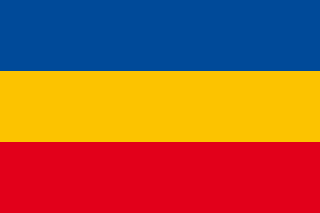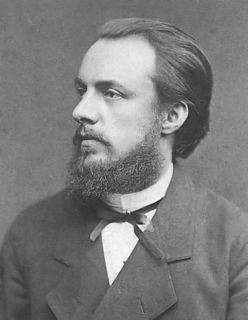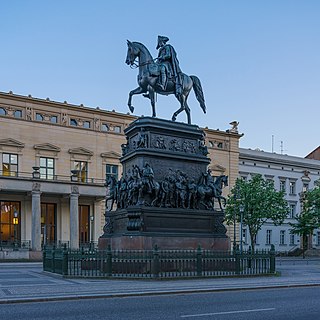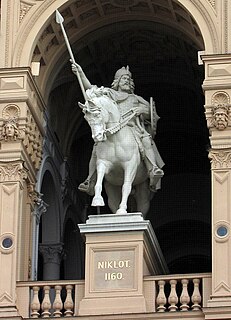This article does not cite any sources .(July 2014) (Learn how and when to remove this template message) |

Ludwig Brunow (9 July 1843, Lutheran - 13 January 1913, Berlin) was a German sculptor.
This article does not cite any sources .(July 2014) (Learn how and when to remove this template message) |

Ludwig Brunow (9 July 1843, Lutheran - 13 January 1913, Berlin) was a German sculptor.
He was the illegitimate child of the local sexton's daughter and spent most of his youth working as a shepherd, but quickly caught up on his education when the opportunity arose. First, he went to Lübz, completing an apprenticeship in carpentry, then found work as a journeyman in Rostock, where he began taking drawing lessons. In 1866, he planned to emigrate to America, but his plans fell through and he became a student of Eduard Lürssen at the Bauakademie in Berlin. The following year, his talent was recognized by the art historian Friedrich Eggers and, at Eggers request, he moved to the Prussian Academy of Art. From 1871 to 1873, he worked as an assistant on the staffs of Rudolf Siemering and Christian Genschow.
He won his first award in 1876 at the Centennial Exhibition in Philadelphia, followed that same year by the "Verdienstkreuz" of the House Order of the Wendish Crown of Mecklenburg-Schwerin. In 1893, he was appointed a "Grand Ducal Professor". In 1901 he closed his studio and stopped accepting large projects. In his spare time, he was a member of a private chamber music quartet, along with the poet Karl Eggers (Friedrich's brother) and Heinrich Seidel. His grave in the Alter Zwölf-Apostel-Kirchhof is unmarked.
An exhaustive list of his works may be found in the corresponding article on German Wikipedia

Schwerin is the capital and second-largest city of the northeastern German state of Mecklenburg-Vorpommern as well as of the region of Mecklenburg, after Rostock. It has around 96,000 inhabitants, and is thus the least populous of all German state capitals.

Ludwigslust is a central castle town of Mecklenburg-Vorpommern, Germany, 40 km south of Schwerin. Since 2011 it has been part of the Ludwigslust-Parchim district.

The Duchy of Mecklenburg-Schwerin was a duchy in northern Germany created in 1701, when Frederick William and Adolphus Frederick II divided the Duchy of Mecklenburg between Schwerin and Strelitz. Ruled by the successors of the Nikloting House of Mecklenburg, Mecklenburg-Schwerin remained a state of the Holy Roman Empire along the Baltic Sea littoral between Holstein-Glückstadt and Duchy of Pomerania.

Paul Friedrich ruled as Grand Duke of Mecklenburg-Schwerin from 1837 to 1842.

Adolphus Frederick II, Duke of Mecklenburg, was the first Duke of the Mecklenburg-Strelitz, reigning from 1701 until his death. Mecklenburg-Strelitz was a part of the Holy Roman Empire.

The Grand Duchy of Mecklenburg-Schwerin was a territory in Northern Germany held by the House of Mecklenburg residing at Schwerin. It was a sovereign member state of the German Confederation and became a federated state of the North German Confederation and finally of the German Empire in 1871.

The House Order of Hohenzollern was a dynastic order of knighthood of the House of Hohenzollern awarded to military commissioned officers and civilians of comparable status. Associated with the various versions of the order were crosses and medals which could be awarded to lower-ranking soldiers and civilians.

Frederick Francis IV was the last Grand Duke of Mecklenburg-Schwerin and regent of Mecklenburg-Strelitz. He inherited the throne when he was fifteen years old in 1897 and was forced to renounce it in 1918.

Adolphus Frederick VI was the last reigning grand duke of Mecklenburg-Strelitz.

Adolphus Frederick V was reigning grand duke of Mecklenburg-Strelitz from 1904 to 1914.

Friedrich August Stüler was an influential Prussian architect and builder. His masterpiece is the Neues Museum in Berlin, as well as the dome of the triumphal arch of the main portal of the Berliner Stadtschloss.

The House and Merit Order of Duke Peter Frederick Louis or proper German Oldenburg House and Merit Order of Duke Peter Frederick Louis was a civil and military order of the Grand Duchy of Oldenburg, a member state of the German Empire. The order was founded by Grand Duke Augustus of Oldenburg on November 27, 1838, to honor his father, Peter Frederick Louis of Oldenburg. It became obsolete in 1918 after the abdication of the last grand duke.

Friedrich Schlie was a German art historian and archaeologist.

Gotthilf Ludwig Möckel or Ludwig Möckel was a German architect

The House Order of Albert the Bear was founded in 1836 as a joint House Order by three dukes of Anhalt from separate branches of the family: Henry, Duke of Anhalt-Köthen, Leopold IV, Duke of Anhalt-Dessau, and Alexander Karl, Duke of Anhalt-Bernburg.

The House Order of the Wendish Crown was an Order of the House of Mecklenburg, jointly instituted on 12 May 1864 by Grand Duke Friedrich Franz II of Mecklenburg-Schwerin and Grand Duke Friedrich Wilhelm of Mecklenburg-Strelitz.

The House Order of Henry the Lion was the House Order of the Duchy of Brunswick. It was instituted by William VIII, Duke of Brunswick on 25 April 1834. The ribbon of the Order was red with yellow edges. It had five grades: Grand Cross, Commander with Sash, Commander, Knight 1st Class, Knight 2nd Class, plus Medal of Merit for Science and Arts, the Cross of Merit and the Medal of Honour.

Wilhelm Georg Johannes Wandschneider was a German sculptor.

The equestrian statue of Frederick the Great is an outdoor sculpture in cast bronze at the east end of Unter den Linden in Berlin, honouring King Frederick II of Prussia. Designed in 1839 by Christian Daniel Rauch and unveiled in 1851, it influenced other monuments. After having been encased in cement for protection during World War II, the statue and its base were removed by the East Germans in 1950 and re-erected in 1963 at Sanssouci in Potsdam, but returned to Unter den Linden in 1980. After German reunification the monument was moved back to its original location and restored. It is a registered monument of the City of Berlin.

Christian Friedrich Genschow was a German sculptor. Although best known for his works at the Schwerin Palace, most of his creations were in smaller formats, in the tradition of the Berliner Bildhauerschule.
| | This section is empty. You can help by adding to it. (March 2018) |
![]() Media related to Ludwig Brunow at Wikimedia Commons
Media related to Ludwig Brunow at Wikimedia Commons